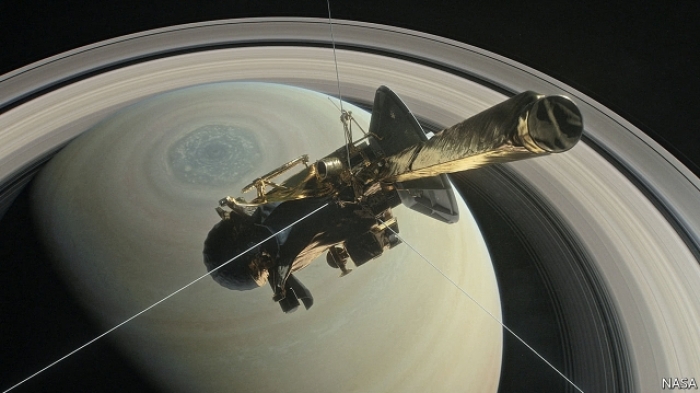After exploring Saturn, Cassini faces a fiery end

Even now, Cassini is in good working order. The three radioisotope generators on ship, which use the slow decay of a lump of plutonium to provide it with electricity, could keep working for decades to come. But the craft would soon run out of rocket fuel, which would mean its trajectory could no longer be controlled. There were plenty of ideas about what to do when that happened; one was to put it into a stable orbit high above Saturn where it could continue making observations for years.
The suicide mission was chosen for two reasons. One was that it would provide a great deal of valuable science. The other was that it would remove the risk that the probe might, in the distant future, collide with one of Saturn’s moons, potentially contaminating it with hardy microbes that might have survived the journey from Earth. That may seem fastidious to the point of paranoia. But thanks to Cassini’s efforts, scientists now count one of Saturn’s moons as among the most promising places in the solar system to look for life.
That moon, called Enceladus, is a tiny ball of ice just 500km across. Its frozen surface reflects much of the dim sunlight that shines upon it, giving a surface temperature of around -200°C. That does not sound very enticing. But in 2005 Cassini spotted plumes of water vapour shooting into space from the moon’s southern pole (the plumes are thought to be the source of one of Saturn’s many rings). The vapour seems to be welling up from an ocean beneath the moon’s icy shell. Exactly how it is kept liquid is a mystery, but friction generated by Saturn’s potent gravity, which kneads and flexes the moon’s core as it orbits its giant parent, seems to be at least part of the answer. Measurements taken by Cassini suggest the ocean covers the entire moon to a depth of perhaps 30-40km.
Water world
As far as terrestrial biochemists know, liquid water’s peculiar properties make it a necessity for life, so subterranean oceans are seen as places worth examining. NASA is planning a mission to Europa, a moon of Jupiter, for just such a reason. But water is not enough by itself. You also need a variety of chemical raw materials to support the reactions necessary for life, and a source of energy to run them.
Thanks to Cassini, scientists know that Enceladus has both. When the probe analysed the plumes in 2008 it found traces of relatively complicated organic molecules that might serve as precursors to life. More recently, in April, it discovered traces of hydrogen in Enceladus’s plumes.
The best current theory to explain the origin of life on Earth is that it began at the bottom of the ocean, in hydrothermal vents—chimney-like outcrops that form when mineral-laden water seeps through hot rocks at the ocean floor. Those early cells would have used hydrogen as an energy source (some modern microbes can perform the same trick). That Enceladus seems to have all the ingredients necessary for a repeat performance has, for astrobiologists at least, transformed it into the most exciting destination in the solar system.
But Enceladus is not the only Saturnian moon with intriguing similarities to Earth. Another trove of spectacular science was provided by the Huygens lander, which set down on Titan on January 14th 2005.
If Enceladus is a tiddler among moons, Titan is a whopper. Its radius of 2,575km makes it bigger than the planet Mercury. It is also the only moon in the solar system with a thick atmosphere, too dense for Earth-bound telescopes to penetrate. But, thanks to photographs taken by Huygens as it plunged through that atmosphere, Titan is known to be one of only two bodies in the solar system (the other being Earth) with free-standing liquid on its surface.
Like Enceladus, Titan is a chilly place, and so those liquids are hydrocarbons rather than water. But, like water, they evaporate into Titan’s atmosphere, from where they fall as rain. These rains produce geological features that are rare elsewhere in the solar system: streams, rivers and tributaries carving valleys and laying down deltas before flowing into large lakes. Besides Titan, only Mars and Earth have similar features. And while Mars’s rivers and lakes have been dry for hundreds of millions of years, Titan’s are still wet today.
The smorgasbord of science provided by Cassini and Huygens has led astronomers to sketch a clutch of follow-up missions, including one to fly a sample of Enceladian water to Earth, and another to drop a robotic boat onto Titan’s lakes. None has yet been given the green light. The long journey (Cassini took more than six years to reach Saturn) means that none could arrive before the end of the next decade at the earliest. But astronomers’ appetites have been thoroughly whetted.















































